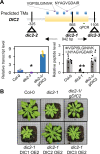The versatility of plant organic acid metabolism in leaves is underpinned by mitochondrial malate-citrate exchange
- PMID: 34498076
- PMCID: PMC8643697
- DOI: 10.1093/plcell/koab223
The versatility of plant organic acid metabolism in leaves is underpinned by mitochondrial malate-citrate exchange
Abstract
Malate and citrate underpin the characteristic flexibility of central plant metabolism by linking mitochondrial respiratory metabolism with cytosolic biosynthetic pathways. However, the identity of mitochondrial carrier proteins that influence both processes has remained elusive. Here we show by a systems approach that DICARBOXYLATE CARRIER 2 (DIC2) facilitates mitochondrial malate-citrate exchange in vivo in Arabidopsis thaliana. DIC2 knockout (dic2-1) retards growth of vegetative tissues. In vitro and in organello analyses demonstrate that DIC2 preferentially imports malate against citrate export, which is consistent with altered malate and citrate utilization in response to prolonged darkness of dic2-1 plants or a sudden shift to darkness of dic2-1 leaves. Furthermore, isotopic glucose tracing reveals a reduced flux towards citrate in dic2-1, which results in a metabolic diversion towards amino acid synthesis. These observations reveal the physiological function of DIC2 in mediating the flow of malate and citrate between the mitochondrial matrix and other cell compartments.
© The Author(s) 2021. Published by Oxford University Press on behalf of American Society of Plant Biologists.
Figures









Similar articles
-
Purification and functional characterization of the vacuolar malate transporter tDT from Arabidopsis.J Biol Chem. 2018 Mar 16;293(11):4180-4190. doi: 10.1074/jbc.RA117.000851. Epub 2018 Jan 24. J Biol Chem. 2018. PMID: 29367340 Free PMC article.
-
Impaired pH homeostasis in Arabidopsis lacking the vacuolar dicarboxylate transporter and analysis of carboxylic acid transport across the tonoplast.Plant Physiol. 2005 Mar;137(3):901-10. doi: 10.1104/pp.104.058453. Epub 2005 Feb 22. Plant Physiol. 2005. PMID: 15728336 Free PMC article.
-
Molecular identification of three Arabidopsis thaliana mitochondrial dicarboxylate carrier isoforms: organ distribution, bacterial expression, reconstitution into liposomes and functional characterization.Biochem J. 2008 Mar 15;410(3):621-9. doi: 10.1042/BJ20070867. Biochem J. 2008. PMID: 18039180
-
Role of organic acids in the integration of cellular redox metabolism and mediation of redox signalling in photosynthetic tissues of higher plants.Free Radic Biol Med. 2018 Jul;122:74-85. doi: 10.1016/j.freeradbiomed.2018.01.016. Epub 2018 Jan 31. Free Radic Biol Med. 2018. PMID: 29355740 Review.
-
Citrate valve integrates mitochondria into photosynthetic metabolism.Mitochondrion. 2020 May;52:218-230. doi: 10.1016/j.mito.2020.04.003. Epub 2020 Apr 8. Mitochondrion. 2020. PMID: 32278088 Review.
Cited by
-
EARLY NODULIN93 acts via cytochrome c oxidase to alter respiratory ATP production and root growth in plants.Plant Cell. 2024 Nov 2;36(11):4716-4731. doi: 10.1093/plcell/koae242. Plant Cell. 2024. PMID: 39179507 Free PMC article.
-
Validation of carbon isotopologue distribution measurements by GC-MS and application to 13C-metabolic flux analysis of the tricarboxylic acid cycle in Brassica napus leaves.Front Plant Sci. 2023 Jan 10;13:885051. doi: 10.3389/fpls.2022.885051. eCollection 2022. Front Plant Sci. 2023. PMID: 36704152 Free PMC article.
-
Roles of WRKY Transcription Factors in Response to Sri Lankan Cassava Mosaic Virus Infection in Susceptible and Tolerant Cassava Cultivars.Plants (Basel). 2025 Apr 8;14(8):1159. doi: 10.3390/plants14081159. Plants (Basel). 2025. PMID: 40284047 Free PMC article.
-
Metabolic evidence for distinct pyruvate pools inside plant mitochondria.Nat Plants. 2022 Jun;8(6):694-705. doi: 10.1038/s41477-022-01165-3. Epub 2022 Jun 9. Nat Plants. 2022. PMID: 35681019
-
Comprehensive In Silico Analysis and Transcriptional Profiles Highlight the Importance of Mitochondrial Dicarboxylate Carriers (DICs) on Hypoxia Response in Both Arabidopsis thaliana and Eucalyptus grandis.Plants (Basel). 2022 Jan 11;11(2):181. doi: 10.3390/plants11020181. Plants (Basel). 2022. PMID: 35050069 Free PMC article.
References
-
- Araújo WL, Tohge T, Nunes-Nesi A, Obata T, Fernie AR (2014) Analysis of kinetic labeling of amino acids and organic acids by GC-MS. InDieuaide-Noubhani M, Alonso AP, eds, Plant Metabolic Flux Analysis: Methods and Protocols. Humana Press, Totowa, NJ, pp 107–119 - PubMed
-
- Ashykhmina N, Lorenz M, Frerigmann H, Koprivova A, Hofsetz E, Stührwohldt N, Flügge U-I, Haferkamp I, Kopriva S, Gigolashvili T (2019) PAPST2 plays critical roles in removing the stress signaling molecule 3′-phosphoadenosine 5′-phosphate from the cytosol and its subsequent degradation in plastids and mitochondria. Plant Cell 31: 231–249 - PMC - PubMed
-
- Baud S, Guyon V, Kronenberger J, Wuillème S, Miquel M, Caboche M, Lepiniec L, Rochat C (2003) Multifunctional acetyl-CoA carboxylase 1 is essential for very long chain fatty acid elongation and embryo development in Arabidopsis. Plant J 33: 75–86 - PubMed
-
- Bernard SM, Habash DZ (2009) The importance of cytosolic glutamine synthetase in nitrogen assimilation and recycling. New Phytol 182: 608–620 - PubMed
-
- Bykova NV, Møller IM, Gardeström P, Igamberdiev AU (2014) The function of glycine decarboxylase complex is optimized to maintain high photorespiratory flux via buffering of its reaction products. Mitochondrion 19: 357–364 - PubMed
Publication types
MeSH terms
Substances
LinkOut - more resources
Full Text Sources
Other Literature Sources
Molecular Biology Databases

